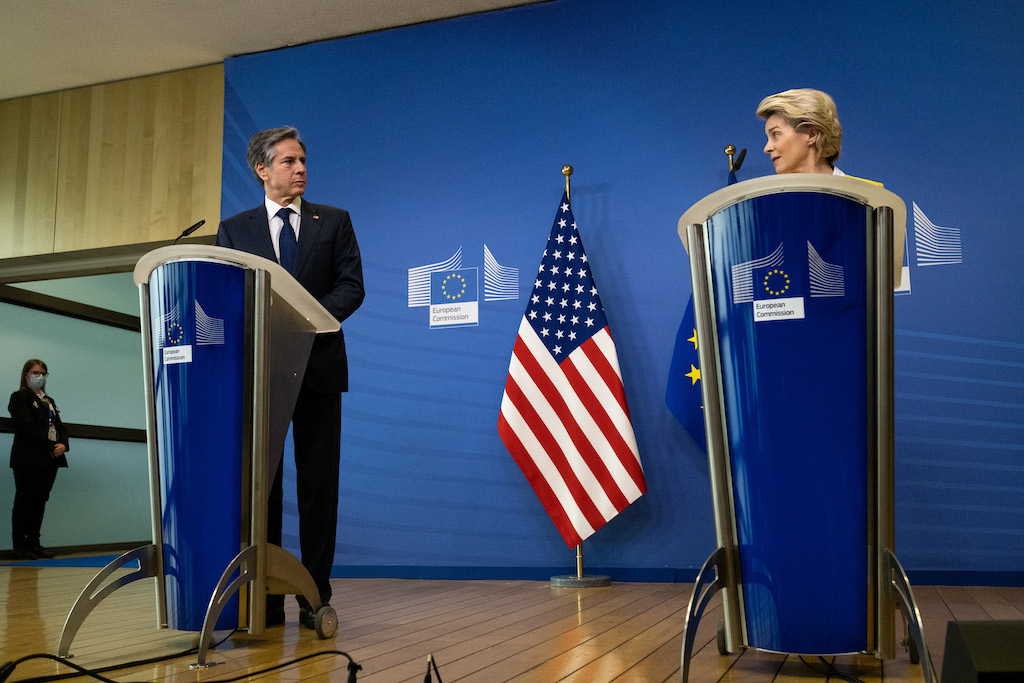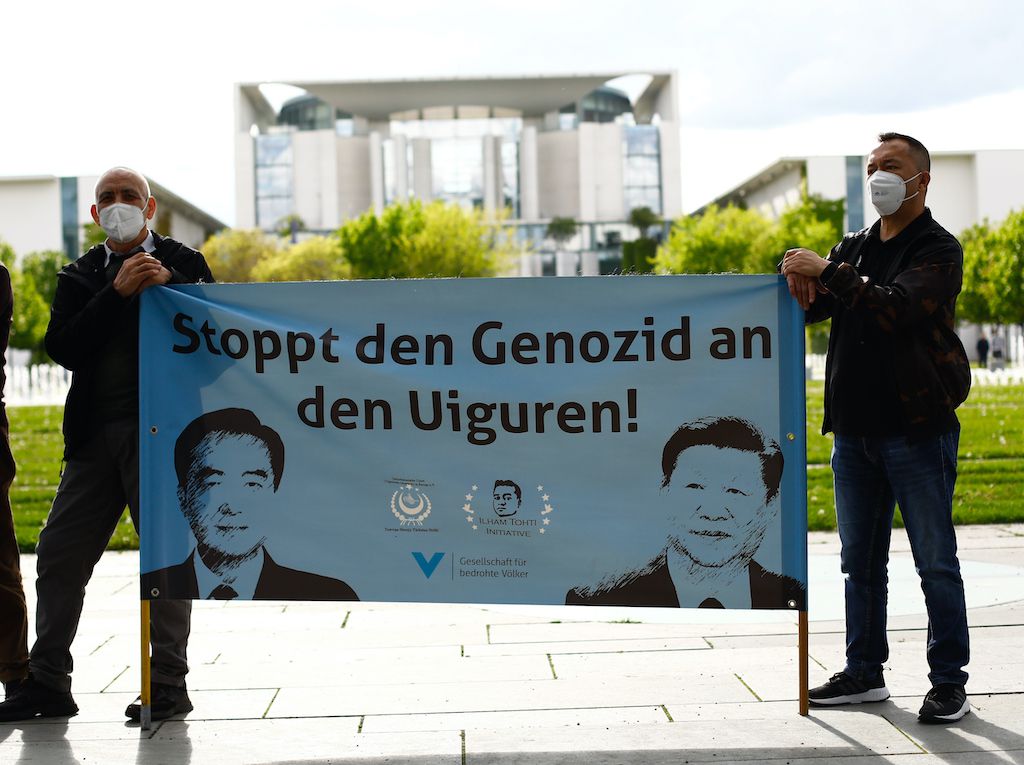Managing China: Scenarios for U.S.-Europe cooperation
The West has awakened to the challenge of managing China, but how far will it go in coordinating its response to Beijing’s combative policies? This depends on a reconciliation of diverging priorities of the leading Western countries.

In a nutshell
- The major capitals of Europe share Washington’s concerns over China’s policies
- However, Western countries still follow diverging security and economic priorities
- Electoral politics will play a role in how they manage China in the future
In 2012, United States Secretary of State Hillary Clinton and European Union High Representative Catherine Ashton released a joint statement on the Asia Pacific region. At the time, the logic of transatlantic cooperation in managing the challenge from China was only beginning to dawn on policymakers in the U.S. and Europe. The subsequent decade has brought the prospects of that cooperation front and center. How they play out will depend on several key variables, including China’s behavior, each side’s prioritization of interests and electoral politics.
Chinese international behavior
This variable is driving public opinion and policy in Western capitals. The list of China’s increasingly combative and otherwise unacceptable policies and actions on the world stage is well-known. The Chinese communist party’s mishandling of the early stages of the Covid-19 outbreak brought greater attention to all of them – from threats to Taiwan, the overturning of Hong Kong’s autonomy, and human rights abuses in Xinjiang that the U.S. government has labeled “genocide.” Then, there are the worries over China’s trade practices and presence in global high-tech supply chains.
Areas of concern here include most prominently the operationalization of explicit Chinese plans to control vast areas of tech, as well as the international regimes that govern new technologies deployment. In the U.S., this is leading Washington to reconsider its traditional support for open international trade and market-driven industrial development. Instead, bipartisan political support is building around protectionist measures and new government subsidies for high-tech research, innovation and production.
The major capitals of Europe share Washington’s concerns over the range of Chinese behavior.
In Europe, where industrial support is nothing new, the concern manifests itself in the proliferation of investment screening mechanisms, in place now in 16 EU member countries, at the EU level and in the United Kingdom. Europeans have also systematically taken a critical eye to China-made equipment in their telecommunications networks and set out to develop new tools for defending their commercial advantages against Chinese subsidies.
In sum, Brussels and the major capitals of Europe (as well as the capitals of some smaller countries) share Washington’s concerns over Chinese behaviors. All are increasingly vocal on issues related to China and managing them.
Security, trade and investment
General agreement in these areas, however, masks diverging priorities. The U.S. has a presence in the Pacific itself, from commonwealths like the Northern Mariana Islands that vote in the U.S. political primaries to the “freely associated states,” over which it exercises authority in defense and security matters, to uninhabited territories. Beyond this, many of its historical relationships in the Pacific have legacies in current security treaty commitments to Japan, Taiwan and others. Consequently, U.S. forces – with primary bases in Hawaii and Japan – flow throughout the region.
Except for France, no other European country has anything approaching this profile in the Indo-Pacific, and even France is far behind the U.S. in its military capacity. For Paris, like all other European capitals, national security priorities lie closer to home: emigration inducing instability in Africa and the Middle East, plus the usual security threat from Russia. Meanwhile, the United Kingdom, historically Europe’s superior naval power, is displaying ever more interest in a regional security presence.
In general, European efforts to contain Chinese influence are more economically weighted than the American approach. The EU has free trade agreements with Japan, South Korea, Vietnam and Singapore, and processes new agreements with Australia, New Zealand, Indonesia, the Philippines and India. In addition, at the end of 2020, the EU reached a preliminary agreement with China on a bilateral investment deal. The ratification process on the Comprehensive Agreement on Investment (CAI) is presently frozen. The two sides imposed sanctions on each other following charges of human rights abuses in Xinjiang province. Beijing and political actors in Europe can be expected to try to defuse the conflict, and “unfreeze” the agreement. The CAI deal was strongly supported by Germany and seen by the European Commission as both an economic opportunity and a way to influence Chinese behavior through engagement. That basic logic has not changed.
Until President Trump, American concerns were wrapped in diplomatic caution.
The numbers reflect the economic stake Europe has in its relationship with China. Trade between Asia and the EU, plus the UK, Norway and Switzerland, amounts to half of all global trade, with the most significant proportion of it between China and Germany. In addition, Europe is the largest international investor in China and a leading investor elsewhere in the region. The attention garnered by its military presence in the Indo-Pacific notwithstanding, the U.S. is a trader and investor in the region on par with Europe. U.S. trade with China, driven by exports, is increasing, as is U.S. investment in China. And although Washington has displayed little energy in its economic statecraft in the last five-six years, the U.S. does have free trade agreements with Singapore, Australia and South Korea.
Electoral politics in the West
There is nothing set in stone in how the governments of the U.S. and Europe address their interests in the Indo-Pacific. In the West, elections matter in the formulation and conduct of foreign policy. While the 2016 election of Donald Trump to the U.S. presidency may have caused some turmoil in relations with Europe, it also brought clarity to U.S. concerns over China’s emergence as a global power. Until the Trump administration, American concerns were wrapped in diplomatic caution. It was not always clear that the president himself cared about some of the most contentious issues in U.S.-China relations, like human rights and China’s threat to Taiwan.
President Trump and some key figures at the Trade Representative’s office, and the commerce and treasury departments had an overriding interest in dealing with economic disputes. But all considered, it is impossible not to characterize the Trump years as a break from his immediate predecessors. This approach galvanized bipartisan Congressional consensus on managing China, and that consensus now serves as the context for President Joe Biden. It will continue to limit the new administration’s policy options.
Brexit – which was driven and facilitated by democratic processes in the UK – has focused London on the urgency to secure new markets in Asia. In addition to bridging the EU trade deals, it was once a part of, the UK is negotiating new arrangements with Australia and New Zealand. Significantly, the country has expressed interest in joining the current 11-member Comprehensive and Progressive Trans-Pacific Partnership (CPTPP). At the same time, the team of Prime Minister Boris Johnson has taken a relatively hard line on several China-related policies, including those on telecommunications networks and Hong Kong.
The European way
Germany’s approach is driven by Chancellor Angela Merkel’s belief that China is essential to German prosperity. Constructive interest in China has been a constant for her. The governing coalition taking office in Berlin after elections in September 2021 may have a different order of priorities. The Greens, who are polling remarkably well, have been particularly critical of the Chinese. But whoever wins, pressure is building on China policy from many sides, including within Ms. Merkel’s party.
National elections in France are slated for next spring. Their impact on China policy depends on the degree to which China becomes a campaign issue. If it gets back on track, the CAI could face final approval in the European Parliament next year in the lead up to the French elections. The deal will remain very controversial in Europe, not least in France. A successful French presidential contender could carve out a negative position during the campaign – particularly if Mr. Macron plays a role in reviving the agreement – and complicate France-China relations when the new government takes office.

Another important wrinkle in European politics is the rising concern over China in its legislatures. The EU parliament has been very vocal. Political groups in parliament representing most members have expressed opposition to the CAI.
Chinese sanctions imposed on sitting members of parliament being their principal objection. The UK Parliament and Bundestag have been very proactive on the Huawei issue – independent of the wishes of their governments. In April, British lawmakers unanimously declared China’s policy in Xinjiang genocide. In France, the Senate adopted a resolution supporting Taiwan. Whoever becomes elected head of state or government in Germany and France will have to account for the activism of the legislatures – as in the U.S. and elsewhere in Europe.
Scenarios
The question is how these variables can combine to shape transatlantic cooperation on the China issue over the next several years.
Most likely scenario
Continued objectionable behavior on the part of the Chinese and election outcomes in Europe, particularly in Germany, widen the aperture for greater U.S.-Europe cooperation. In this scenario, the Chinese do not back off the sanctioning of EU parliamentarians that triggered the CAI freeze. As a result, the CAI remains stalled. The U.S. and EU double down on joint efforts to address China-associated trade issues, and they continue to make common cause on human rights, technology, and Taiwan policy.
President Biden’s “competitive, collaborative and adversarial” framework for manging China and the EU’s “partner, competitive, rival” concept are mirror images. Under this scenario, the Western allies maintain their interest in compartmentalizing elements of their China relationships to keep it from becoming too confrontational. However, efforts by the Chinese to leverage economic advantages and cooperation on mutual interests, like climate change, fail.
Less likely scenario
China’s objectionable behavior continues, but election outcomes reinforce European interest in autonomy and sensitivity to China-related economic linkages. In this scenario, a face-saving solution is found to Chinese sanctions on EU parliamentarians, and the CAI is approved. As a result of continued net positive relations with China and the opposite with the U.S., the EU and the U.S. have a more difficult time developing common approaches.
Under this scenario, the U.S. and the UK find a greater common interest in addressing and managing the China challenge. Yet, at the same time, continental Europe tries to position itself as a third, independent force in the Indo-Pacific. This strategy strains its relations with the U.S.
In both the first and second scenario, U.S. and EU convene cooperative mechanisms like the EU-U.S. strategic dialogue on China and the EU-proposed Trade and Technology Council. But under scenario one, these efforts find agreement in critical areas like World Trade Organization reform, technology standard-setting, and infrastructure cooperation. In the second scenario, they are dead letters. The U.S. relies on the sort of pressure that characterized much of the recent interaction regarding Chinese technology.
Least likely scenario
This eventuality involves a significant change in Chinese behavior, including, for example, an end to abuses in Xinjiang, a pulling back from recent action on Hong Kong, a halt to pressure on Taiwan, and changes in domestic development priorities involving high tech. All this is highly unlikely. Each issue is deeply rooted in the Chinese system.
Were it to somehow happen, depending on the extent of change, both the U.S. and Europe would revert to their pre-2012 approach to managing China. The shift would channel efforts from cooperation on the China threat to economic competition there and open far greater opportunity to work with Beijing on global challenges.








